Employability in Action Module: Reflective Report on Workplace Changes
VerifiedAdded on 2023/06/03
|7
|1676
|445
Report
AI Summary
This reflective report analyzes a student's work experiences at XYZ Company, focusing on their roles as a customer support executive and team leader. The report utilizes the Gibbs reflective cycle to describe the student's experiences, feelings, evaluations, and analyses of their career progression. It highlights the challenges of work-life balance, the development of leadership skills, and the importance of decision-making processes. The report concludes with a self-assessment of strengths and weaknesses, outlining a plan of action to improve communication and technical skills, and emphasizes the impact of workplace changes on employee performance. The student reflects on how they adapted to a new environment and the benefits of a promotion, concluding that while changes can be difficult, they ultimately enhance performance and provide valuable learning experiences.
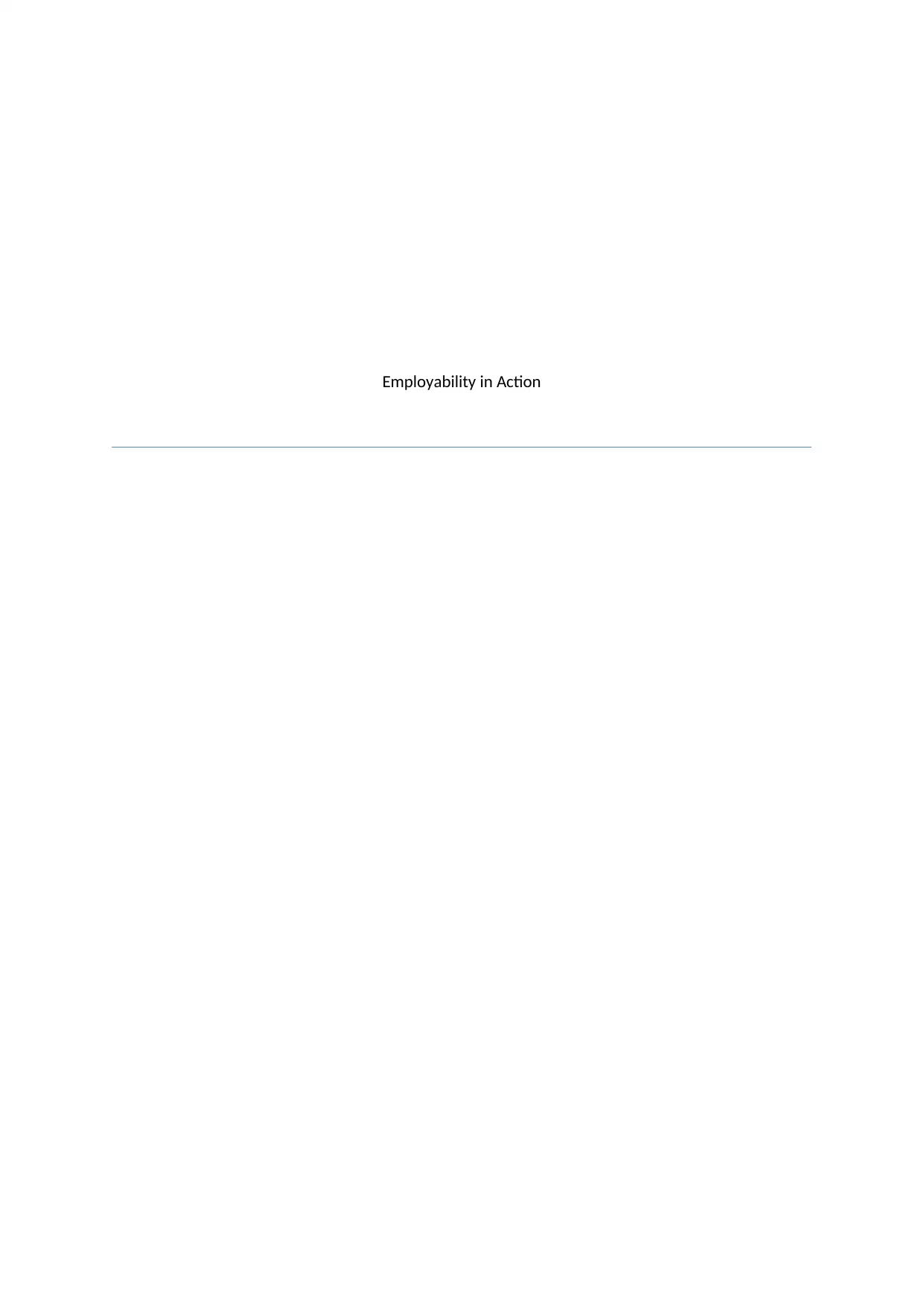
Employability in Action
Paraphrase This Document
Need a fresh take? Get an instant paraphrase of this document with our AI Paraphraser
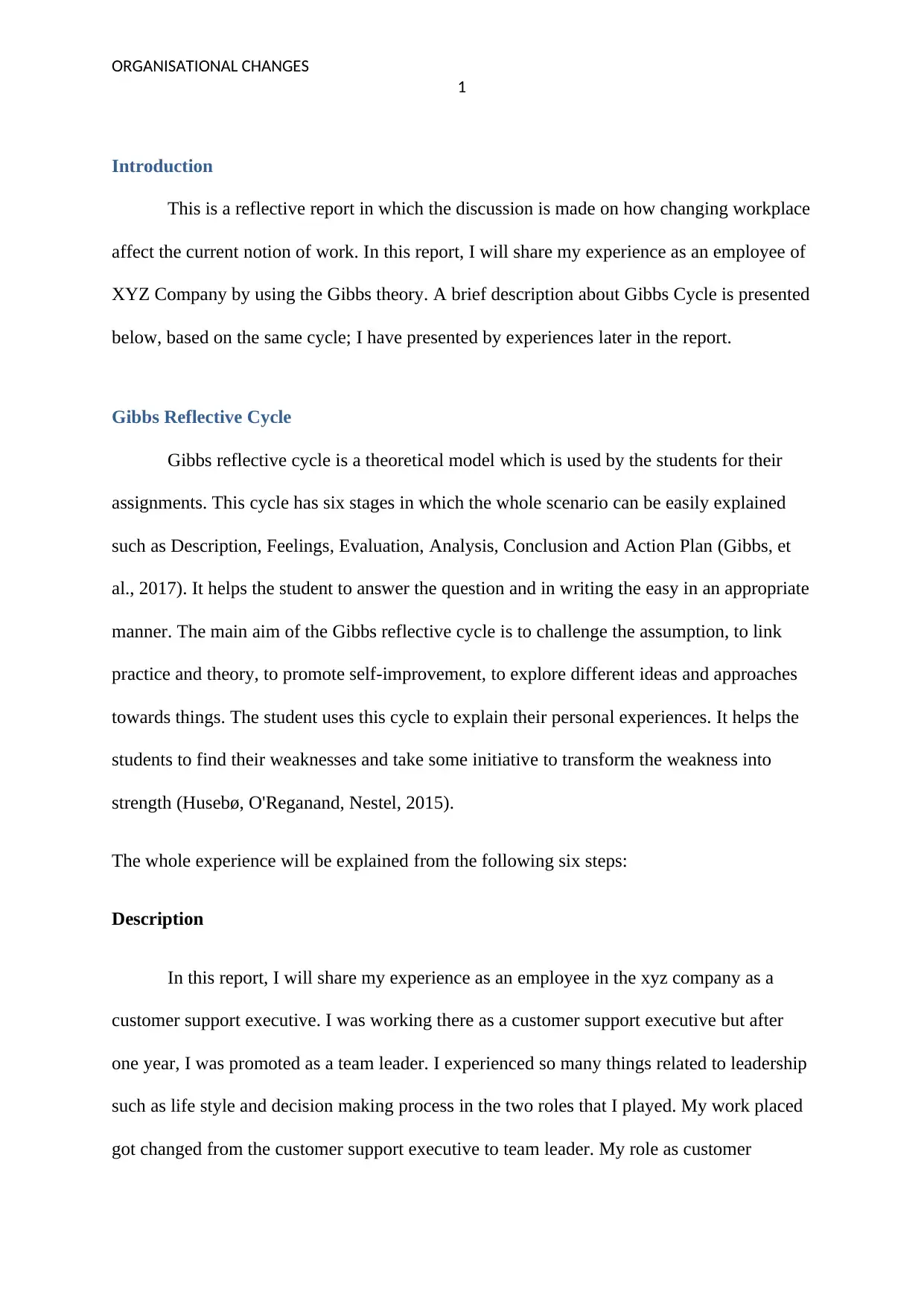
ORGANISATIONAL CHANGES
1
Introduction
This is a reflective report in which the discussion is made on how changing workplace
affect the current notion of work. In this report, I will share my experience as an employee of
XYZ Company by using the Gibbs theory. A brief description about Gibbs Cycle is presented
below, based on the same cycle; I have presented by experiences later in the report.
Gibbs Reflective Cycle
Gibbs reflective cycle is a theoretical model which is used by the students for their
assignments. This cycle has six stages in which the whole scenario can be easily explained
such as Description, Feelings, Evaluation, Analysis, Conclusion and Action Plan (Gibbs, et
al., 2017). It helps the student to answer the question and in writing the easy in an appropriate
manner. The main aim of the Gibbs reflective cycle is to challenge the assumption, to link
practice and theory, to promote self-improvement, to explore different ideas and approaches
towards things. The student uses this cycle to explain their personal experiences. It helps the
students to find their weaknesses and take some initiative to transform the weakness into
strength (Husebø, O'Reganand, Nestel, 2015).
The whole experience will be explained from the following six steps:
Description
In this report, I will share my experience as an employee in the xyz company as a
customer support executive. I was working there as a customer support executive but after
one year, I was promoted as a team leader. I experienced so many things related to leadership
such as life style and decision making process in the two roles that I played. My work placed
got changed from the customer support executive to team leader. My role as customer
1
Introduction
This is a reflective report in which the discussion is made on how changing workplace
affect the current notion of work. In this report, I will share my experience as an employee of
XYZ Company by using the Gibbs theory. A brief description about Gibbs Cycle is presented
below, based on the same cycle; I have presented by experiences later in the report.
Gibbs Reflective Cycle
Gibbs reflective cycle is a theoretical model which is used by the students for their
assignments. This cycle has six stages in which the whole scenario can be easily explained
such as Description, Feelings, Evaluation, Analysis, Conclusion and Action Plan (Gibbs, et
al., 2017). It helps the student to answer the question and in writing the easy in an appropriate
manner. The main aim of the Gibbs reflective cycle is to challenge the assumption, to link
practice and theory, to promote self-improvement, to explore different ideas and approaches
towards things. The student uses this cycle to explain their personal experiences. It helps the
students to find their weaknesses and take some initiative to transform the weakness into
strength (Husebø, O'Reganand, Nestel, 2015).
The whole experience will be explained from the following six steps:
Description
In this report, I will share my experience as an employee in the xyz company as a
customer support executive. I was working there as a customer support executive but after
one year, I was promoted as a team leader. I experienced so many things related to leadership
such as life style and decision making process in the two roles that I played. My work placed
got changed from the customer support executive to team leader. My role as customer
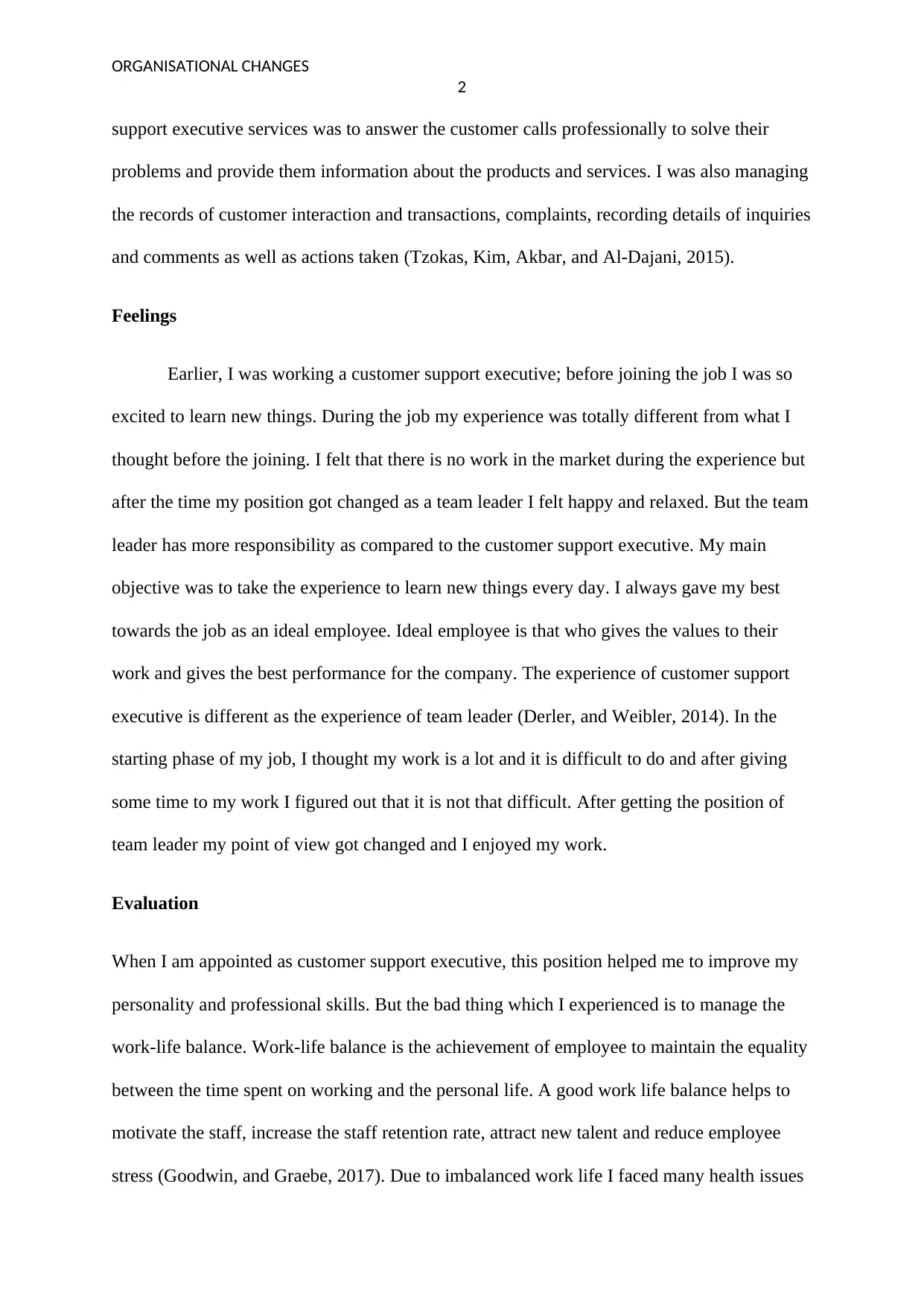
ORGANISATIONAL CHANGES
2
support executive services was to answer the customer calls professionally to solve their
problems and provide them information about the products and services. I was also managing
the records of customer interaction and transactions, complaints, recording details of inquiries
and comments as well as actions taken (Tzokas, Kim, Akbar, and Al-Dajani, 2015).
Feelings
Earlier, I was working a customer support executive; before joining the job I was so
excited to learn new things. During the job my experience was totally different from what I
thought before the joining. I felt that there is no work in the market during the experience but
after the time my position got changed as a team leader I felt happy and relaxed. But the team
leader has more responsibility as compared to the customer support executive. My main
objective was to take the experience to learn new things every day. I always gave my best
towards the job as an ideal employee. Ideal employee is that who gives the values to their
work and gives the best performance for the company. The experience of customer support
executive is different as the experience of team leader (Derler, and Weibler, 2014). In the
starting phase of my job, I thought my work is a lot and it is difficult to do and after giving
some time to my work I figured out that it is not that difficult. After getting the position of
team leader my point of view got changed and I enjoyed my work.
Evaluation
When I am appointed as customer support executive, this position helped me to improve my
personality and professional skills. But the bad thing which I experienced is to manage the
work-life balance. Work-life balance is the achievement of employee to maintain the equality
between the time spent on working and the personal life. A good work life balance helps to
motivate the staff, increase the staff retention rate, attract new talent and reduce employee
stress (Goodwin, and Graebe, 2017). Due to imbalanced work life I faced many health issues
2
support executive services was to answer the customer calls professionally to solve their
problems and provide them information about the products and services. I was also managing
the records of customer interaction and transactions, complaints, recording details of inquiries
and comments as well as actions taken (Tzokas, Kim, Akbar, and Al-Dajani, 2015).
Feelings
Earlier, I was working a customer support executive; before joining the job I was so
excited to learn new things. During the job my experience was totally different from what I
thought before the joining. I felt that there is no work in the market during the experience but
after the time my position got changed as a team leader I felt happy and relaxed. But the team
leader has more responsibility as compared to the customer support executive. My main
objective was to take the experience to learn new things every day. I always gave my best
towards the job as an ideal employee. Ideal employee is that who gives the values to their
work and gives the best performance for the company. The experience of customer support
executive is different as the experience of team leader (Derler, and Weibler, 2014). In the
starting phase of my job, I thought my work is a lot and it is difficult to do and after giving
some time to my work I figured out that it is not that difficult. After getting the position of
team leader my point of view got changed and I enjoyed my work.
Evaluation
When I am appointed as customer support executive, this position helped me to improve my
personality and professional skills. But the bad thing which I experienced is to manage the
work-life balance. Work-life balance is the achievement of employee to maintain the equality
between the time spent on working and the personal life. A good work life balance helps to
motivate the staff, increase the staff retention rate, attract new talent and reduce employee
stress (Goodwin, and Graebe, 2017). Due to imbalanced work life I faced many health issues
⊘ This is a preview!⊘
Do you want full access?
Subscribe today to unlock all pages.

Trusted by 1+ million students worldwide
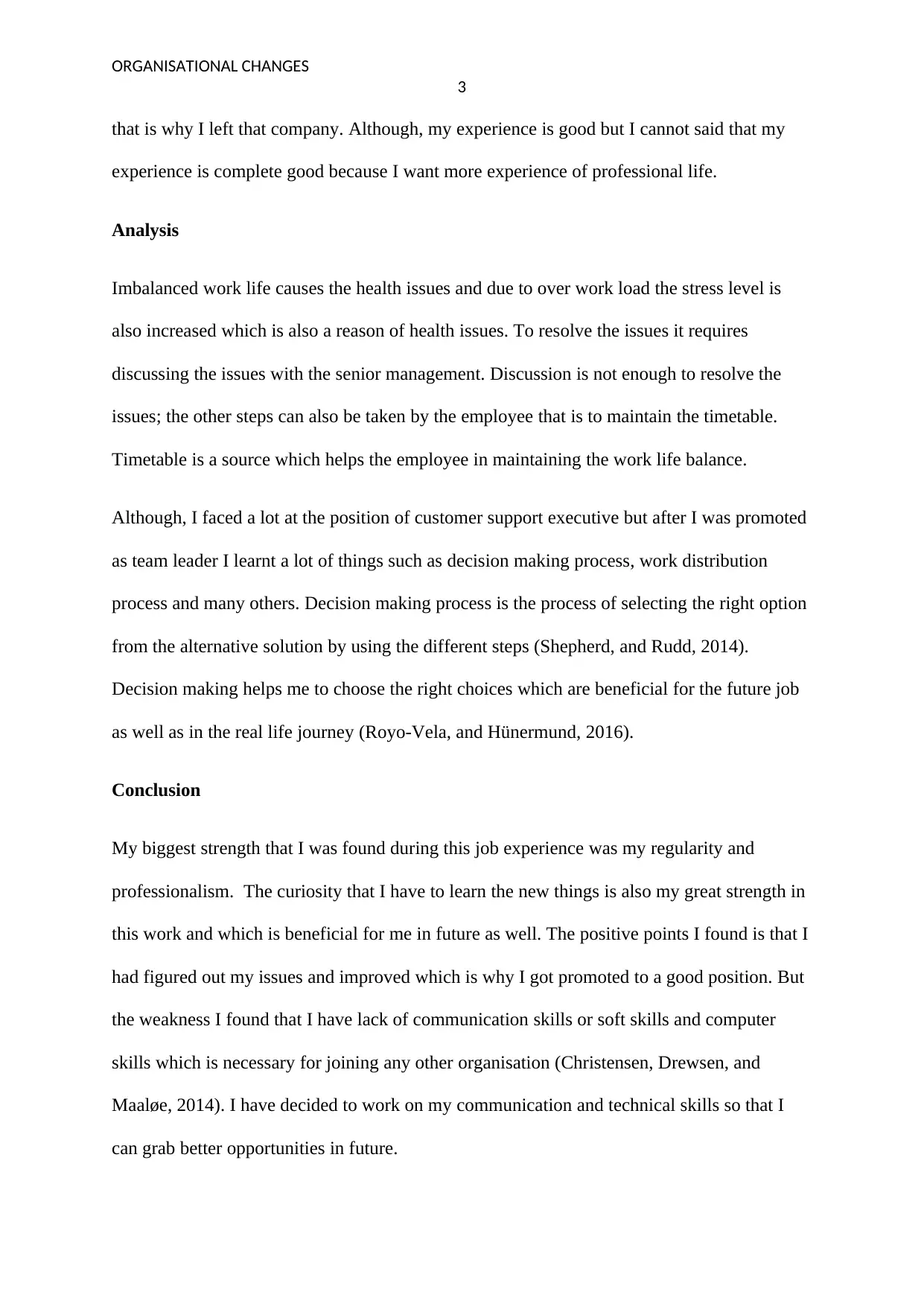
ORGANISATIONAL CHANGES
3
that is why I left that company. Although, my experience is good but I cannot said that my
experience is complete good because I want more experience of professional life.
Analysis
Imbalanced work life causes the health issues and due to over work load the stress level is
also increased which is also a reason of health issues. To resolve the issues it requires
discussing the issues with the senior management. Discussion is not enough to resolve the
issues; the other steps can also be taken by the employee that is to maintain the timetable.
Timetable is a source which helps the employee in maintaining the work life balance.
Although, I faced a lot at the position of customer support executive but after I was promoted
as team leader I learnt a lot of things such as decision making process, work distribution
process and many others. Decision making process is the process of selecting the right option
from the alternative solution by using the different steps (Shepherd, and Rudd, 2014).
Decision making helps me to choose the right choices which are beneficial for the future job
as well as in the real life journey (Royo-Vela, and Hünermund, 2016).
Conclusion
My biggest strength that I was found during this job experience was my regularity and
professionalism. The curiosity that I have to learn the new things is also my great strength in
this work and which is beneficial for me in future as well. The positive points I found is that I
had figured out my issues and improved which is why I got promoted to a good position. But
the weakness I found that I have lack of communication skills or soft skills and computer
skills which is necessary for joining any other organisation (Christensen, Drewsen, and
Maaløe, 2014). I have decided to work on my communication and technical skills so that I
can grab better opportunities in future.
3
that is why I left that company. Although, my experience is good but I cannot said that my
experience is complete good because I want more experience of professional life.
Analysis
Imbalanced work life causes the health issues and due to over work load the stress level is
also increased which is also a reason of health issues. To resolve the issues it requires
discussing the issues with the senior management. Discussion is not enough to resolve the
issues; the other steps can also be taken by the employee that is to maintain the timetable.
Timetable is a source which helps the employee in maintaining the work life balance.
Although, I faced a lot at the position of customer support executive but after I was promoted
as team leader I learnt a lot of things such as decision making process, work distribution
process and many others. Decision making process is the process of selecting the right option
from the alternative solution by using the different steps (Shepherd, and Rudd, 2014).
Decision making helps me to choose the right choices which are beneficial for the future job
as well as in the real life journey (Royo-Vela, and Hünermund, 2016).
Conclusion
My biggest strength that I was found during this job experience was my regularity and
professionalism. The curiosity that I have to learn the new things is also my great strength in
this work and which is beneficial for me in future as well. The positive points I found is that I
had figured out my issues and improved which is why I got promoted to a good position. But
the weakness I found that I have lack of communication skills or soft skills and computer
skills which is necessary for joining any other organisation (Christensen, Drewsen, and
Maaløe, 2014). I have decided to work on my communication and technical skills so that I
can grab better opportunities in future.
Paraphrase This Document
Need a fresh take? Get an instant paraphrase of this document with our AI Paraphraser
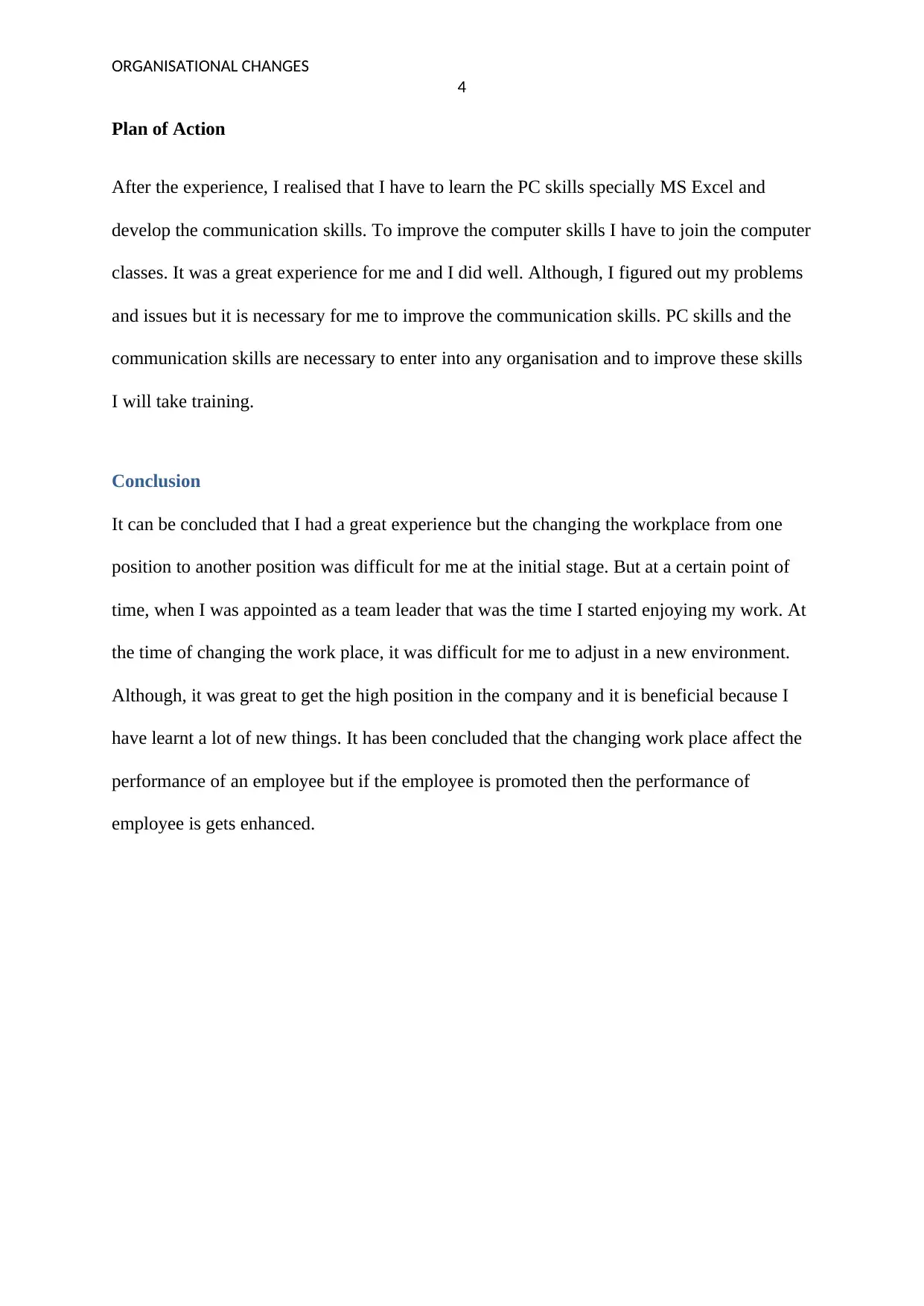
ORGANISATIONAL CHANGES
4
Plan of Action
After the experience, I realised that I have to learn the PC skills specially MS Excel and
develop the communication skills. To improve the computer skills I have to join the computer
classes. It was a great experience for me and I did well. Although, I figured out my problems
and issues but it is necessary for me to improve the communication skills. PC skills and the
communication skills are necessary to enter into any organisation and to improve these skills
I will take training.
Conclusion
It can be concluded that I had a great experience but the changing the workplace from one
position to another position was difficult for me at the initial stage. But at a certain point of
time, when I was appointed as a team leader that was the time I started enjoying my work. At
the time of changing the work place, it was difficult for me to adjust in a new environment.
Although, it was great to get the high position in the company and it is beneficial because I
have learnt a lot of new things. It has been concluded that the changing work place affect the
performance of an employee but if the employee is promoted then the performance of
employee is gets enhanced.
4
Plan of Action
After the experience, I realised that I have to learn the PC skills specially MS Excel and
develop the communication skills. To improve the computer skills I have to join the computer
classes. It was a great experience for me and I did well. Although, I figured out my problems
and issues but it is necessary for me to improve the communication skills. PC skills and the
communication skills are necessary to enter into any organisation and to improve these skills
I will take training.
Conclusion
It can be concluded that I had a great experience but the changing the workplace from one
position to another position was difficult for me at the initial stage. But at a certain point of
time, when I was appointed as a team leader that was the time I started enjoying my work. At
the time of changing the work place, it was difficult for me to adjust in a new environment.
Although, it was great to get the high position in the company and it is beneficial because I
have learnt a lot of new things. It has been concluded that the changing work place affect the
performance of an employee but if the employee is promoted then the performance of
employee is gets enhanced.
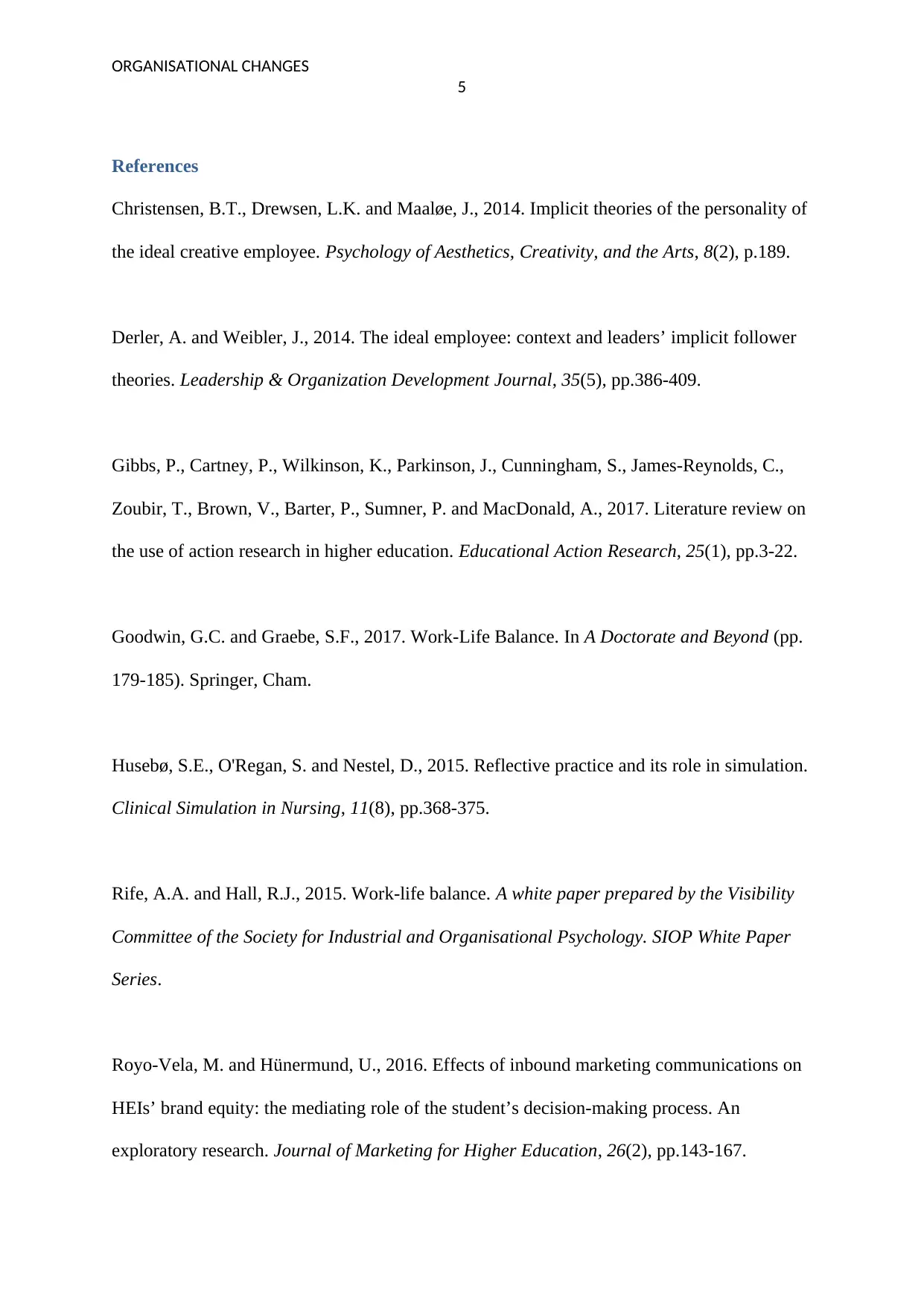
ORGANISATIONAL CHANGES
5
References
Christensen, B.T., Drewsen, L.K. and Maaløe, J., 2014. Implicit theories of the personality of
the ideal creative employee. Psychology of Aesthetics, Creativity, and the Arts, 8(2), p.189.
Derler, A. and Weibler, J., 2014. The ideal employee: context and leaders’ implicit follower
theories. Leadership & Organization Development Journal, 35(5), pp.386-409.
Gibbs, P., Cartney, P., Wilkinson, K., Parkinson, J., Cunningham, S., James-Reynolds, C.,
Zoubir, T., Brown, V., Barter, P., Sumner, P. and MacDonald, A., 2017. Literature review on
the use of action research in higher education. Educational Action Research, 25(1), pp.3-22.
Goodwin, G.C. and Graebe, S.F., 2017. Work-Life Balance. In A Doctorate and Beyond (pp.
179-185). Springer, Cham.
Husebø, S.E., O'Regan, S. and Nestel, D., 2015. Reflective practice and its role in simulation.
Clinical Simulation in Nursing, 11(8), pp.368-375.
Rife, A.A. and Hall, R.J., 2015. Work-life balance. A white paper prepared by the Visibility
Committee of the Society for Industrial and Organisational Psychology. SIOP White Paper
Series.
Royo-Vela, M. and Hünermund, U., 2016. Effects of inbound marketing communications on
HEIs’ brand equity: the mediating role of the student’s decision-making process. An
exploratory research. Journal of Marketing for Higher Education, 26(2), pp.143-167.
5
References
Christensen, B.T., Drewsen, L.K. and Maaløe, J., 2014. Implicit theories of the personality of
the ideal creative employee. Psychology of Aesthetics, Creativity, and the Arts, 8(2), p.189.
Derler, A. and Weibler, J., 2014. The ideal employee: context and leaders’ implicit follower
theories. Leadership & Organization Development Journal, 35(5), pp.386-409.
Gibbs, P., Cartney, P., Wilkinson, K., Parkinson, J., Cunningham, S., James-Reynolds, C.,
Zoubir, T., Brown, V., Barter, P., Sumner, P. and MacDonald, A., 2017. Literature review on
the use of action research in higher education. Educational Action Research, 25(1), pp.3-22.
Goodwin, G.C. and Graebe, S.F., 2017. Work-Life Balance. In A Doctorate and Beyond (pp.
179-185). Springer, Cham.
Husebø, S.E., O'Regan, S. and Nestel, D., 2015. Reflective practice and its role in simulation.
Clinical Simulation in Nursing, 11(8), pp.368-375.
Rife, A.A. and Hall, R.J., 2015. Work-life balance. A white paper prepared by the Visibility
Committee of the Society for Industrial and Organisational Psychology. SIOP White Paper
Series.
Royo-Vela, M. and Hünermund, U., 2016. Effects of inbound marketing communications on
HEIs’ brand equity: the mediating role of the student’s decision-making process. An
exploratory research. Journal of Marketing for Higher Education, 26(2), pp.143-167.
⊘ This is a preview!⊘
Do you want full access?
Subscribe today to unlock all pages.

Trusted by 1+ million students worldwide
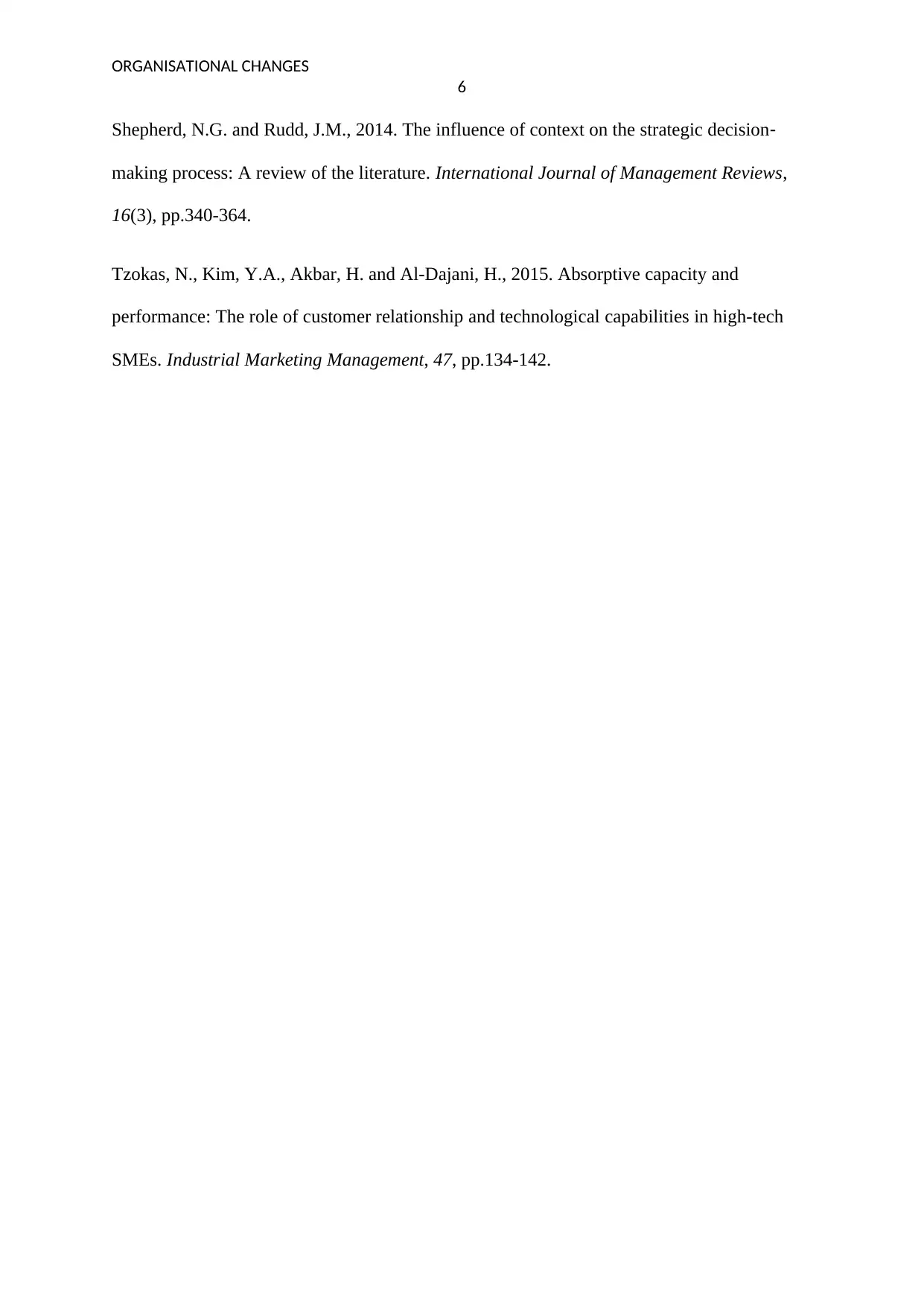
ORGANISATIONAL CHANGES
6
Shepherd, N.G. and Rudd, J.M., 2014. The influence of context on the strategic decision‐
making process: A review of the literature. International Journal of Management Reviews,
16(3), pp.340-364.
Tzokas, N., Kim, Y.A., Akbar, H. and Al-Dajani, H., 2015. Absorptive capacity and
performance: The role of customer relationship and technological capabilities in high-tech
SMEs. Industrial Marketing Management, 47, pp.134-142.
6
Shepherd, N.G. and Rudd, J.M., 2014. The influence of context on the strategic decision‐
making process: A review of the literature. International Journal of Management Reviews,
16(3), pp.340-364.
Tzokas, N., Kim, Y.A., Akbar, H. and Al-Dajani, H., 2015. Absorptive capacity and
performance: The role of customer relationship and technological capabilities in high-tech
SMEs. Industrial Marketing Management, 47, pp.134-142.
1 out of 7
Related Documents
Your All-in-One AI-Powered Toolkit for Academic Success.
+13062052269
info@desklib.com
Available 24*7 on WhatsApp / Email
![[object Object]](/_next/static/media/star-bottom.7253800d.svg)
Unlock your academic potential
Copyright © 2020–2025 A2Z Services. All Rights Reserved. Developed and managed by ZUCOL.





